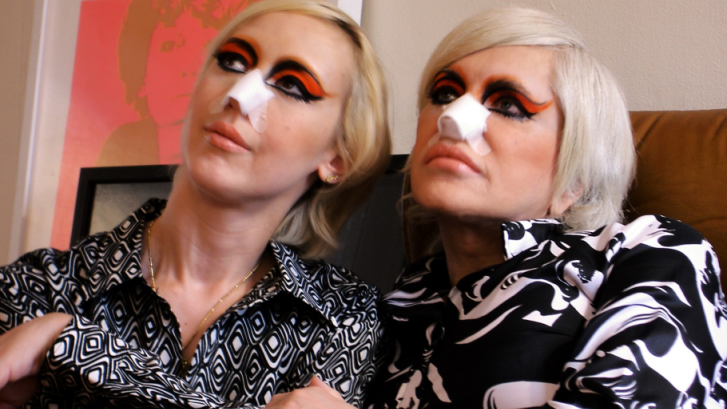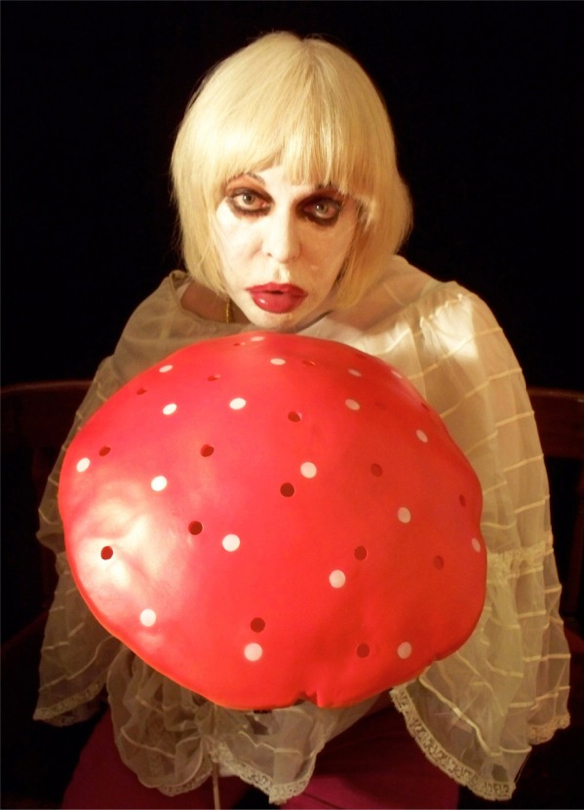The Ballad of Genesis and Lady Jaye

In an intimate way Genesis P-Orridge tells the story of his relationship with Jacqueline Breyer alias Lady Jaye. En passant one gets an insight into their personal gender-concept of “pandrogeny” and the beginnings of British industrial-music.
This is a love story, and a portrait of two lives that illustrate the transformative powers of both love and art. In warm and intimate images captured handheld, Losier crafts a labyrinthine mise-en-scene of interviews, home movies, and performance footage. The film documents a truly new brand of Romantic consciousness, one in defiance of the daily dehumanization of the body by the pervasive presence of advertising and pornography.
----
THE BALLAD OF GENESIS AND LADY JAYE is a film about Genesis Breyer P-Orridge, well-known for his work with Throbbing Gristle and Psychic TV, and his life and work partner Lady Jaye (née Jacqueline Breyer). One would expect the film to be about the history of industrial music, about Genesis as a link between the pre- and post-punk era, about the underground scene since the 1970s. And it is, but it tells the story from the perspective of a great romantic love that began in the 1990s. Genesis and Lady Jaye start to undergo surgical procedures to merge into a third being, a pandrogynous being.
THE BALLAD OF GENESIS AND LADY JAYE is also a film by Marie Losier, a filmmaker whose trademark is to playfully build up a very personal relationship with her underground role models. Kitchen and garden shots alternate with home-movie performances, magic tricks and archival footage. The film maintains its dynamic rhythm – with the help of Genesis’s cut-up narratives – even when Lady Jaye’s unexpected death turns it into a film about mourning. From that point it revolves around the question of how to die when two have merged into one – and how to go on living.
Stefanie Schulte Strathaus
The body is simply a suitcase
I first saw Genesis perform seven years ago at the Knitting Factory, the now legendary club in Tribeca. Watching him perform was pure enchantment. His words from the stage hovered somewhere between song and speech, deeply poetic, primitive, at times frightful. It completely hypnotized me. I knew immediately that I had to film this perplexing and powerful figure, perhaps as a way of understanding what I had experienced, but moreover to have proof of the existence of a being I was convinced had arrived from somewhere else! In a typically miraculous New York City coincidence, I met Genesis at a gallery opening in Soho, in one of those sardine-can spaces where you can barely walk and hardly breathe. Being relatively small, I got pressed into a corner where I inadvertently stepped on someone’s toes. I turned to apologize and there was Genesis smiling, his gold-capped teeth glittering down over me. We spoke briefly, but in that time I felt something special had passed between us. He asked me about my films and gave me his e-mail address. Whether it was fate or pure clumsiness, this marked the beginning of an artistic collaboration that would develop into a close friendship.
Like many others who have encountered him, I saw in Genesis the simple and profound notion that the manner in which you live your life is the highest and most unimpeachable form of art that exists. “My project is not about gender,” he said. “Some feel like a man trapped in a woman’s body, others like a woman trapped in a man’s body. The pandrogyne says, ’I just feel trapped in a body.’ The body is simply the suitcase that carries us around. Pandrogyny is all about the mind, consciousness.”
A constantly changing appearance
Both Genesis and Lady Jaye were born with life-changing illnesses, imprinting upon them from an early age an incredibly complex relationship to their bodies. Later in life, they became gender variant activists, their mutating appearance based on gestural aesthetics, a living project documented through their collaborative paintings, photographs, writings and performances.
The passing of Lady Jaye in 2007 is central to my film. I thought this tragic event would prevent me from continuing to shoot, but to Genesis, the completion of this film would be the most appropriate way to honor his love and life with Jaye, a message of hope and solidarity with artists and lovers everywhere, regardless of gender or sexual orientation. By allowing me unprecedented access over these past many years to film their professional and personal lives, they have provided me with material that I believe transcends most fiction films, but whose message is ultimately grounded in the most humanistic and basic of desires: the affirmation of love.
I envision the film as an agile, mobile, hand-spliced patchwork of iconic images – one that captures the constant activity, flow and theatricality of the lives of Genesis and Lady Jaye. Woven from stories, memories, dreams, music and interviews, several portions of the film were shot in a studio and employed elaborate costumes and choreography to dramatize key moments in the lives of Genesis and Lady Jaye. Much of it was shot using a silent Bolex 16mm film camera. Since I primarily shoot alone, the Bolex has become a vital part of my body, almost like an extra hand. I approach my subjects as if it were the beginning age of cinema, the time of Georges Méliès and the Lumière Brothers, by creating tableaux vivants, comical and colorful mise en scène, and recreating stories and interviews. Through the re-enactment of scenes from their own lives, what begins to emerge is a truth that far exceeds the conventions of traditional documentary filmmaking. It is instead a form of psychodrama that allows my subjects to step outside of themselves and their fixed habits of mind. Hidden or unknown parts of their personality begin to emerge; through the veil of fiction one begins to understand a person’s fantasy life, their secret wishes and desires, their most powerful feelings about the world and their place in it.
Marie Losier
Fellini meets documentary
Marie’s technique is very revolutionary. Most documentaries – and I’ve been in a lot of documentaries: I’ve been in documentaries about Joy Division, Brion Gysin, Burroughs, Derek Jarman – all kinds of stuff. But they’re all the same, they sit you down and they stick a camera at you and it’s just your head, and you’re just going blah, blah, blah, blah, blah… and it’s very ordinary. There’s nothing very interesting and radical happening. But with Marie there’s animation and she gets you to wear the most ludicrous costumes and do these bizarre things, and at the time you’re doing them you’re thinking, “What the hell has this got to do with my life?” But when it’s all assembled, it’s like Fellini meets documentary. It’s a very new, radical way of making documentaries, and quite honestly, we think what Marie does and the way she does it will be the template for the future. She is totally unique, very deep with a great sense of joy and emotions below her humor.
Genesis Breyer P-Orridge, 2009
details
-
Runtime
75 min -
Country
United States, France -
Year of Presentation
2011 -
Year of Production
2011 -
Director
Marie Losier -
Cast
Genesis Breyer P-Orridge, Lady Jaye Breyer P-Orridge (aka Jacqueline Breyer P-Orridge), Big Boy (Breyer P-Orridge), Edley Odowd, David Max, Markus Persson, Alice Genese, Bryin Dall, Tony Conrad, Caleigh Fisher, Gibby Haynes, Clyde Magid, Marti Domination, Caresse P-Orridge Balpazari, Genesse P-Orridge, Lili Chopra, Peaches -
Production Company
Marie Losier -
Berlinale Section
Forum -
Berlinale Category
Documentary-, Essay Film -
Teddy Award Winner
Best Documentary/ Essay Film
pictures from the movie
Biography Marie Losier
Marie Losier, born in 1972 in France, is a filmmaker based in New York. She first studied literature at the University of Nanterre, France, and then Fine Arts in New York City, where she also worked as a film curator. Marie Losier has made a number of film portraits of avant- garde directors, musicians, and composers, such as Mike and George Kuchar, Guy Maddin, Richard Foreman, and Tony Conrad. She has also performed in films by George Kuchar, Mike Kuchar, and Jackie Raynal, and in plays by Juliana Francis and Tony Torn. Currently she's working on a new film about Cassandro. Her films and videos have been shown at museums, galleries, biennials, and festivals.
Filmography Marie Losier
2008 Papal Broken Dance | 2012 Byun, Found and Object | 2014 Alan Vega - Just a Million Dreams
Biography Genesis Breyer P-Orridge
Genesis P-Orridge was born on February 22, 1950 in Manchester, England as Neil Andrew Megson. He is an actor and composer, known for The Raspberry Reich (2004), The Dinner (2017) and Ghost at No. 9 (2005). He was previously married to Lady Jaye Breyer P'Orridge.

